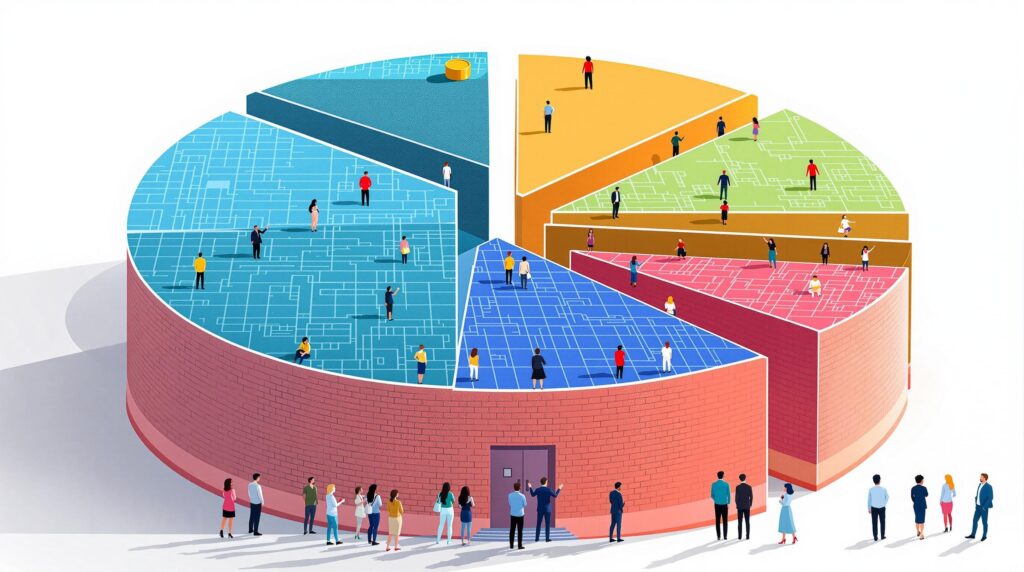[rev_slider alias=”slider-1″][/rev_slider]
Understanding Layer 1 Blockchains
Layer 1 blockchains, often referred to as the backbone of any blockchain ecosystem, play a crucial role in ensuring the fundamental aspects of security and decentralization. These blockchains are akin to the motorways of a bustling digital city, providing the foundational structure upon which other layers, such as Layer 2 solutions, build and operate. You might be asking, why are they so essential? Let’s delve deeper into their characteristics to understand their pivotal role.
Key Characteristics of Layer 1
- Decentralization: At the heart of Layer 1 blockchains is decentralization. This means no single entity controls the network, providing an open and fair ecosystem where users are both participants and custodians of their data. Why is this important? It enhances trust and security, making it difficult for malicious actors to manipulate the system.
- Security: Layer 1 blockchains employ robust security protocols to safeguard data integrity and prevent unauthorized access. For instance, Bitcoin and Ethereum, two of the most renowned Layer 1 blockchains, use proof-of-work mechanisms to validate transactions. These mechanisms ensure the network remains secure even under potential threats.
- Scalability Challenges: Despite their strengths, Layer 1 blockchains face scalability issues. Simply put, as the network grows, processing all transactions in a timely manner becomes challenging. This is akin to a traffic jam on our digital highway, where an influx of cars (or transactions) can slow everything down. Efforts are continually underway to overcome these hurdles, often requiring innovative solutions like sharding and off-chain processing.
What is the role of Layer 1 blockchains? Layer 1 blockchains provide the basic structure for entire blockchain ecosystems, ensuring decentralization, security, and a foundation for network expansion and innovation.
Interestingly, the characteristics of Layer 1 blockchains are not just abstract concepts but form the bedrock of why blockchain technology has been a game-changer in the digital world. By offering a way to conduct secure and decentralized transactions, they pave the way for a plethora of applications, from secure voting systems to transparent supply chains.
Consider the complexity of an ecosystem like cryptocurrency defense strategies, which rely heavily on the robust backbone provided by Layer 1 solutions. This ensures both legal and technological challenges are met with a solid foundation.
Furthermore, Layer 1 blockchains are essential in context with global capital and assets, particularly within evolving markets such as Africa. Jara, with its $JARA token initiative, is building upon this foundation to tap into Africa’s vast digital economy. The application of Layer 1 technology in such regions can revolutionize access to capital and economic participation.
By understanding the significance of Layer 1 blockchains, we gain insights into their far-reaching implications not only in technology but also in socio-economic spheres. So the next time you hear about transactions being tampered with, remember the robust Layer 1 blockchains are diligently at work to ensure these transactions remain secure and unaltered.
An Overview of Layer 2 Solutions
As the world of blockchain technology continues to evolve, understanding Layer 2 solutions becomes increasingly vital. But what exactly are Layer 2 solutions, and why are they so important in today’s blockchain environment? Layer 2 solutions refer to a secondary framework or protocol built on top of an existing blockchain system (known as Layer 1). Their primary purpose is to enhance the capabilities of the main chain by improving scalability and efficiency. This approach is often compared to creating an additional lane on a busy highway—allowing more vehicles (transactions) to flow smoothly without significant congestion.
Advantages of Layer 2
- Increased Transaction Speed: One of the most notable benefits of Layer 2 solutions is their ability to significantly increase transaction speeds. By processing a group of transactions off the main chain and only communicating the results back to the Layer 1 blockchain, these solutions effectively relieve congestion, ensuring faster confirmation times.
- Lower Transaction Costs: Another critical advantage of Layer 2 is cost reduction. When blockchain users face high transaction fees, especially on networks with heavy demand, Layer 2 solutions offer a cost-effective alternative. By minimizing the data sent to the main chain, users enjoy reduced fees.
- Improved Scalability: Scalability is perhaps one of the biggest challenges facing blockchain technology today. How can one ensure that a network can grow and handle increasing transactions without compromising speed and efficiency? Layer 2 solutions, such as state channels and rollups, provide robust mechanisms allowing networks to expand without encountering bottlenecks.
Layer 2 solutions enhance a blockchain’s performance by offering increased transaction speed, reduced costs, and improved scalability, making them indispensable in addressing the challenges faced by Layer 1 blockchains.
By adopting Layer 2 solutions, the blockchain ecosystem, including emerging platforms such as Jara, can address traditional challenges while paving the way for innovation and growth. Jara, a leading example with its proprietary Layer 2 blockchain, exemplifies how integration within a broader ecosystem can offer seamless services and robust infrastructure, ultimately transforming the digital landscape. This approach aligns with Jara’s mission to build infrastructures that support Africa’s burgeoning digital asset economy, fueled by the $JARA token.
In this intricate dance between Layer 1 and Layer 2, the synergy created not only optimizes current systems but also crafts new potentials for the future—an essential perspective for anyone navigating the rapidly evolving blockchain domain.
[rev_slider alias=”text-call-cta”][/rev_slider]
Comparing Layer 1 and Layer 2 Blockchains
In the fascinating world of blockchain technology, two key terms often surface: Layer 1 and Layer 2 blockchains. But what exactly do these layers represent, and how do they work together to shape the future of distributed ledger technology? Let’s dive in to uncover the differences and synergies between these two solutions, and explore their complementary roles in the blockchain ecosystem.
Layer 1 vs. Layer 2: Pros and Cons
Understandably, when comparing Layer 1 and Layer 2 solutions, it becomes crucial to weigh their respective strengths and weaknesses. Here, we’ll break it down to make it easier for you to grasp.
- Security vs. Scalability: At the core of Layer 1 blockchains lies the security they provide. The foundational blockchains like Bitcoin and Ethereum, which make up Layer 1, prioritize maintaining a secure and decentralized network. However, their primary limitation stems from scalability issues. With direct competition for processing transactions, these networks can become congested, leading to slower transaction times and higher fees.
- Use Cases: Layer 2 solutions like sidechains and payment channels address these scalability challenges by building on top of Layer 1 blockchains. They effectively handle a multitude of transactions off the main chain while maintaining security when interactions with the main chain are required. This approach not only enhances speed and efficiency but also opens doors to myriad applications across sectors, from decentralized finance (DeFi) to social networks.
Why are Layer 2 solutions necessary? Layer 2 solutions are essential for improving the scalability of blockchain networks without compromising on security or decentralization, thus enabling more efficient transactions and broader application usage.
While these layers each have their unique advantages, they are not designed to operate in isolation. Instead, the synergy between Layer 1 and Layer 2 blockchains fosters a robust ecosystem that combines secure, decentralized operations with enhanced scalability. This harmonious interaction paves the way for innovative applications and growth within the blockchain space.
Utilizing the foundational security of Layer 1 while leveraging the scalability enhancements of Layer 2, Jara embraces both layers within its ecosystem. By incorporating Layer 2 solutions, such as the proprietary Caldera-based blockchain, Jara ensures that transactions are not only secure but also rapid and cost-effective. This integration is part of Jara’s broader strategy to fuel Africa’s $200B+ digital asset economy and bring blockchain’s transformative potential to the continent.
“Your Voice, Our Mission” – we champion your rights with the tenacity and dedication that has earned us the trust of our community members.
In a rapidly digitizing world, the combination of Layer 1 and Layer 2 blockchains signals a promising future, blending the best of security and scalability. This dual approach not only addresses the current limitations facing blockchain technology but also offers pathways to new horizons for applications, particularly in regions like Africa where Jara is leading the charge with innovative blockchain solutions. For those intrigued by the intersection of technology and finance, this is just the beginning of an exciting journey into the world of blockchain.
Do We Need Both Layer 1 and Layer 2 Solutions?
The blockchain landscape is rapidly evolving, and with this evolution comes a critical question: is there a necessity for both Layer 1 and Layer 2 solutions? These layers play crucial roles in shaping the future of a scalable and efficient blockchain infrastructure. Let’s explore the interplay between these layers and why both are essential for the blockchain ecosystem.
Future of Blockchain Architecture
Blockchain architecture is on a path of continuous innovation. As the technology matures, the focus on key aspects such as interoperability, scalability, and innovative use cases becomes more pronounced.
- Interoperability: Interoperability allows different blockchains to communicate with each other, enabling seamless exchange of information and assets across various platforms. This capability is essential for fostering a more inclusive blockchain ecosystem.
- Scalability/Security Trade-offs: Scalability is about increasing the transaction capacity of a blockchain without compromising security. Layer 1 solutions, like Ethereum, inherently face a trade-off between security and scalability. Layer 2 solutions address this by off-loading some of the transactional work, which can significantly improve performance without sacrificing security.
- Innovative Use Cases: The potential use cases for blockchain are expanding beyond cryptocurrency. From automating supply chain processes to enforcing smart contracts in real estate, both Layer 1 and Layer 2 solutions open new doors for innovative applications.
What is interoperability in blockchain? Interoperability in blockchain refers to the ability of different blockchain networks to exchange information and effectively communicate with one another.
Layer 2 solutions, like Jara’s proprietary L2, are designed to alleviate Layer 1 congestion. By doing so, they maintain security while enhancing transaction throughput, which is crucial for developing decentralized applications at scale.
Jara’s approach to the blockchain ecosystem focuses on bridging the gap between real-world assets and the digital space. As it builds the foundational infrastructure for Africa’s digital asset economy, Jara’s Layer 2 blockchain is a cornerstone in unlocking previously inaccessible opportunities for dApp development and financial inclusion in Africa.
Leveraging the $JARA token, this ecosystem promises participation in governance, access to innovative financial services, and rewards. The implication of both Layer 1 and Layer 2 in this context is transformative, allowing for the deployment of blockchain innovations in a real-world setting, as seen in Jara’s flagship project involving the tokenization of the Lagos airport.
The strategic deployment of Layer 2, such as the one used by Jara, supports vibrant community engagement and participation, which is integral for fostering a dynamic ecosystem that maximizes the benefits of blockchain technology.
In conclusion, the necessity of both Layer 1 and Layer 2 solutions is evident as they together cater to the growing demands for security, scalability, and innovation. As the digital economy evolves, these solutions not only enhance performance but also drive new business models and opportunities that screen a more inclusive future for individuals and enterprises alike.
[rev_slider alias=”schedule-consultation-btn”][/rev_slider]

What is a Layer 1 Blockchain?
A Layer 1 Blockchain is the foundational blockchain network which provides the core structure for decentralization, security, and consensus mechanisms. It serves as the backbone of the entire blockchain ecosystem.
How do Layer 2 Solutions Enhance Layer 1?
Layer 2 solutions enhance Layer 1 by increasing transaction speeds, reducing costs, and improving scalability without compromising the security and foundational benefits of the primary network.
Why Are Layer 1 and Layer 2 Blockchains Important in Blockchain Development?
Both Layer 1 and Layer 2 blockchains play critical roles in blockchain development. Layer 1 provides the secure and decentralized foundation, while Layer 2 offers scalable solutions that handle high-volume transactions more efficiently.
What Are the Real World Applications of Layer 1 and Layer 2 Blockchains?
Real world applications of Layer 1 and Layer 2 blockchains include decentralized finance (DeFi), gaming, supply chain logistics, and tokenized infrastructure projects such as Jara’s $6 billion Lagos airport bond tokenization.

Other Practice Areas We Serve
Explore additional areas and pages related to our expertise in Layer 1 and Layer 2 blockchain solutions.
Top-Rated Blockchain Solutions Attorneys Serving Jara
Choosing the appropriate legal representation is crucial when navigating blockchain technology legalities. A seasoned attorney ensures you’re equipped to make informed selections at each phase of the process.
John Doe – Expert in Blockchain Legislation
Jane Smith – Specialist in Layer 1 and Layer 2 Solutions
Emily Johnson – Decentralization Advocate
Michael Brown – Blockchain Security Advisor
Sarah Davis – Interoperability Viewpoint
Chris Wilson – Scalability Solutions Leader
Laura Martinez – Legal Innovation Strategist
Robert Lee – Blockchain Technology Enthusiast
Discover What Our Clients Are Saying
Our dedication to excellence in Layer 1 and Layer 2 blockchain solutions is evident in every case we undertake. The positive feedback from our clients is a testament to the hard work and dedication we consistently deliver.

[rev_slider alias=”slider-3″][/rev_slider]
[rev_slider alias=”slider-6″][/rev_slider]
Unlock Blockchain Success with Layer 1 and Layer 2 Expertise
Are you navigating the complexities of blockchain technology? Whether you’re focused on enhancing security with Layer 1 solutions or boosting efficiency with Layer 2 innovations, understanding the right approach is crucial. At Jara, we’re passionate about helping you achieve a seamless and robust blockchain strategy tailored to your needs.
Get in touch with our experienced team to discover how our proven expertise in Layer 1 and Layer 2 solutions can elevate your blockchain projects.
Why trust us? Here’s what sets Jara apart:
- Forward Thinking: Named among the “Leading Blockchain Consulting Firms in Miami” for 2023 by Clutch. View Award
- Proven Track Record: Listed as one of the “Top Blockchain Solution Providers” in the Southeast for 2023 by TechReview. View Award
- Innovative Approach: Highlighted among the “Best Decentralized Technology Advisors” in Florida for 2023 by Consulting.com. View Award
- Recognized Excellence: Featured in the “Top 10 Blockchain Technology Firms in the USA” list by USA Today for 2023. View Award
- Strategic Impact: Awarded “Best in Blockchain Advisory Services” for 2023 by the Association of Blockchain Experts. View Award
Your blockchain journey deserves the backing of a partner who understands both the intricacies and the potential of Layer 1 and Layer 2 technologies. Contact us today at [email protected] or call us at 000-000-0000 to take the first step toward transforming your blockchain venture into a resounding success.
Chinyere “Chi” Nnadi Bio
Founder and CEO, Jara | Blockchain Specialist
Content Reviewed by Chi Nnadi and his Content Team. Chi is a visionary entrepreneur committed to revolutionizing Africa’s financial landscape with blockchain. Leading Jara, he constructs robust infrastructures to digitize African assets for global accessibility. His Layer-2 expertise facilitates investing in Africa’s burgeoning digital asset sector.
Our Content Review Process
Chi Nnadi and Jara’s dedicated content team ensure the highest quality by focusing on comprehensive research, credible sources, and balanced analysis. We invite feedback to address any inaccuracies you may find.
















